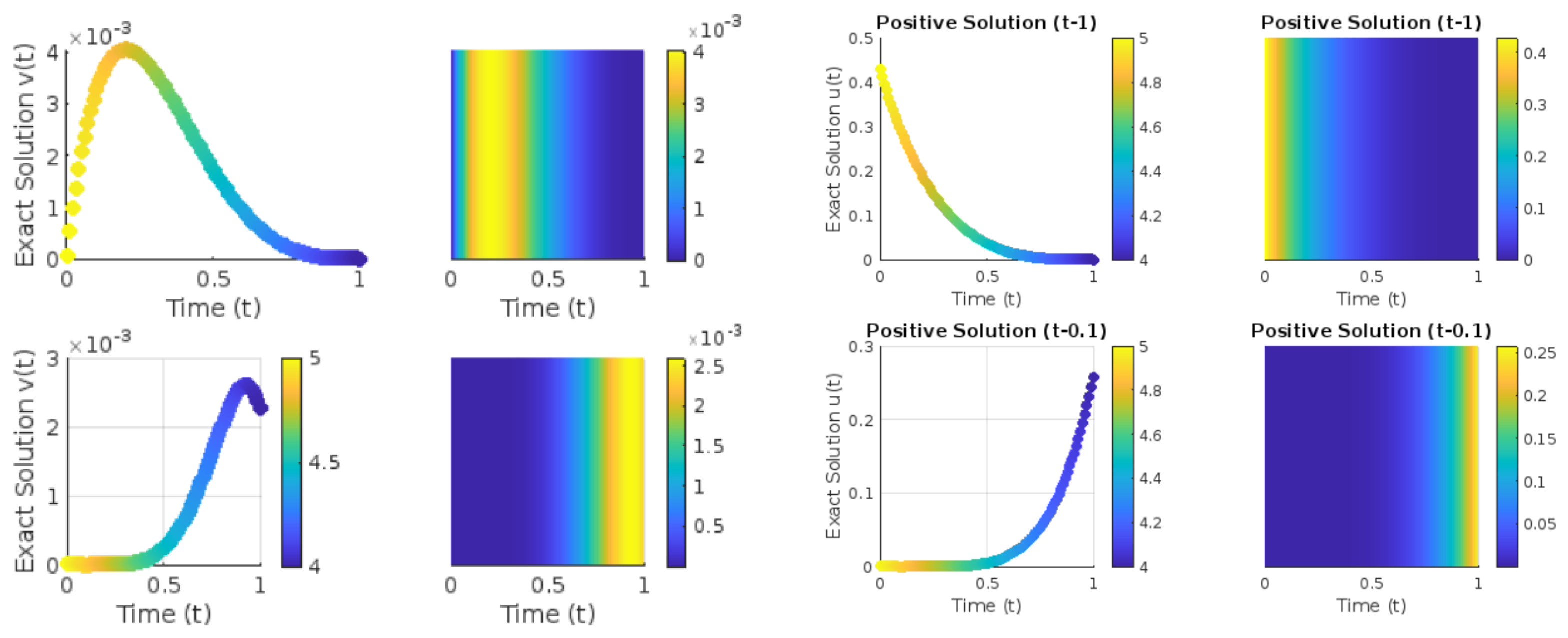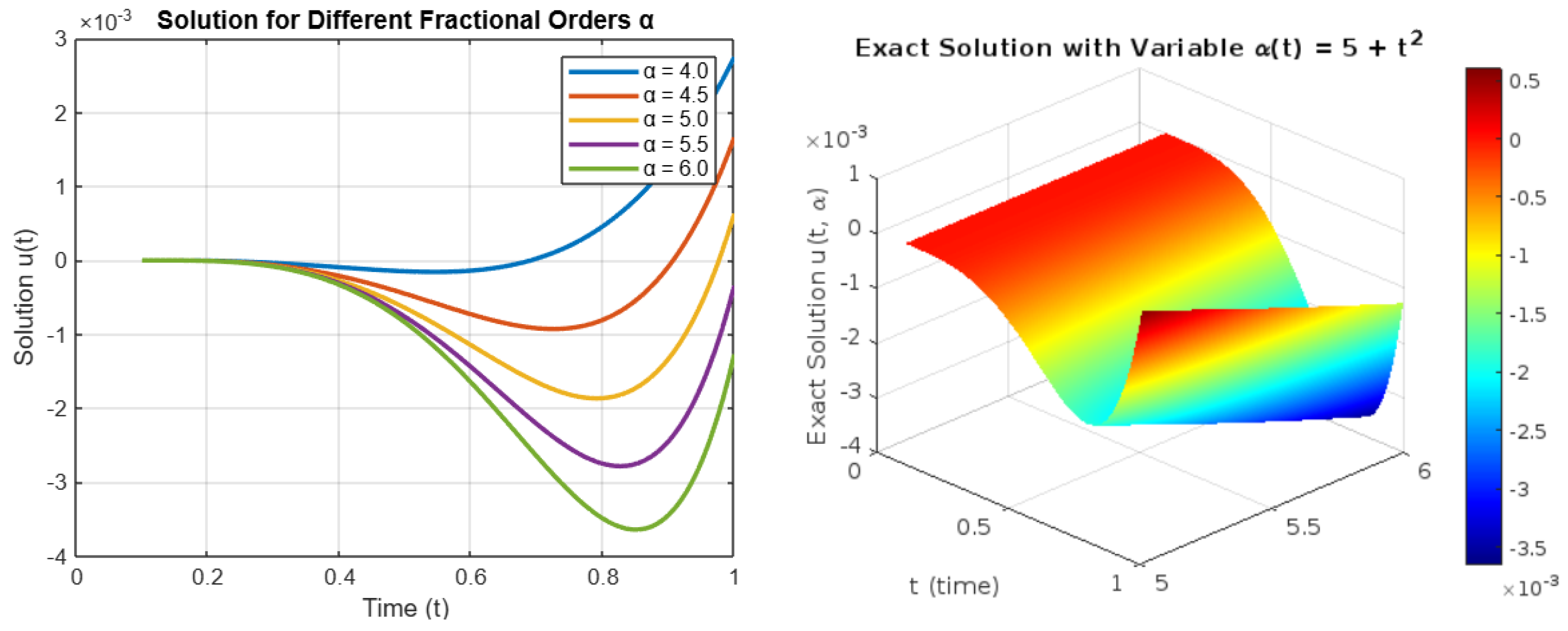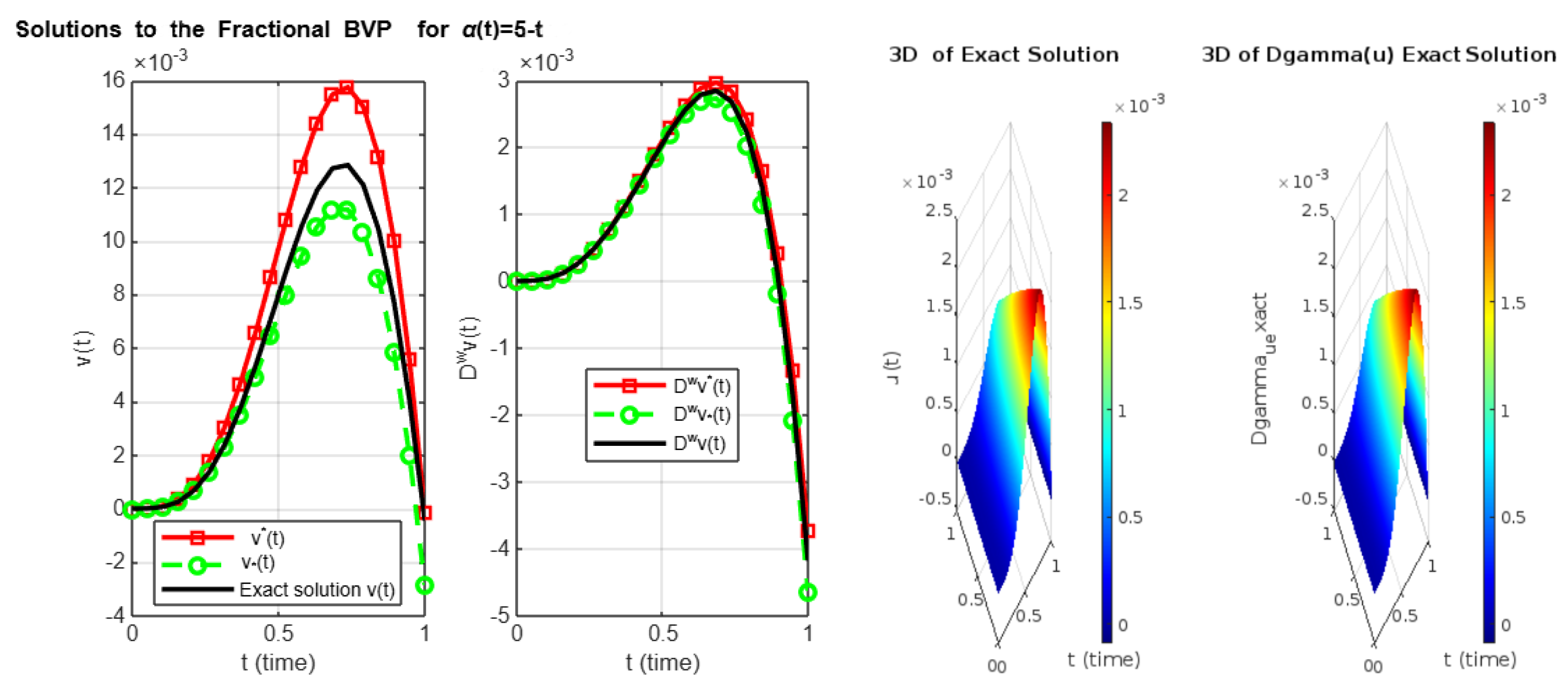Solutions to Variable-Order Fractional BVPs with Multipoint Data in Ws,p Spaces
Abstract
1. Introduction
2. Essential Concepts and Preliminaries
- (i)
- uniformly for ,
- (ii)
- uniformly for ,
3. Problem Setup
4. Example
5. Numerical Analysis
6. Conclusions
Author Contributions
Funding
Data Availability Statement
Conflicts of Interest
References
- Ozarslan, R.; Bas, E.; Baleanu, D.; Acay, B. Fractional physical problems including wind-influenced projectile motion with Mittag-Leffler kernel. AIMS Math. 2020, 5, 467–481. [Google Scholar] [CrossRef]
- Singh, J.; Kumar, D.; Baleanu, D. On the analysis of chemical kinetics system pertaining to a fractional derivative with Mittag-Leffler type kernel. Chaos 2017, 27, 103113. [Google Scholar] [CrossRef] [PubMed]
- Prajapati, J.C.; Patel, A.D.; Pathak, K.N.; Shukla, A.K. Fractional calculus approach in the study of instability phenomenon in fluid dynamics. Palest. J. Math. 2012, 1, 95–103. [Google Scholar]
- Giusti, A. On infinite order differential operators in fractional viscoelasticity. Fract. Calc. Appl. Anal. 2017, 20, 854–867. [Google Scholar] [CrossRef]
- Oldham, K.B. Fractional differential equations in electrochemistry. Adv. Eng. Softw. 2010, 41, 9–12. [Google Scholar] [CrossRef]
- Alotta, G.; Di Paola, M.; Pinnola, F.P. An unified formulation of strong non-local elasticity with fractional order calculus. Commun. Nonlinear Sci. Numer. Simul. 2022, 57, 793–805. [Google Scholar] [CrossRef]
- Uchaikin, V.V. Fractional Derivatives for Physicists and Engineers; Springer: Berlín, Germany, 2013. [Google Scholar]
- Rehman, Z.U.; Boulaaras, S.; Jan, R.; Ahmad, I.; Bahramand, S. Computational analysis of financial system through non-integer derivative. J. Comput. Sci. 2024, 75, 102204. [Google Scholar] [CrossRef]
- Traore, A.; Sene, N. Model of economic growth in the context of fractional derivative. Alex. Eng. J. 2024, 59, 4843–4850. [Google Scholar] [CrossRef]
- Ionescu, C.; Lopes, A.; Copot, D.; Machado, J.T.; Bates, J.H. The role of fractional calculus in modeling biological phenomena: A review. Commun. Nonlinear Sci. Numer. Simul. 2017, 51, 141–159. [Google Scholar] [CrossRef]
- Shiria, B.; Baleanu, D. Numerical solution of some fractional dynamical systems in medicine involving non-singular kernel with vector order. Results Nonlinear Anal. 2019, 2, 160–168. [Google Scholar]
- Yang, X.; Zeng, J.; Xu, C.; Peng, L.; Alsultan, J. Modeling of fractional differential equation in cloud computing image fusion algorithm. Appl. Math. Nonlinear Sci. 2023, 8, 1125–1134. [Google Scholar] [CrossRef]
- Dhayal, R.; Malik, M.; Abbas, S. Nonlinear heat conduction equations with memory: Physical meaning and analytical results. J. Math. Phys. 2017, 58, 063501. [Google Scholar] [CrossRef]
- Dhayal, R.; Malik, M.; Abbas, S. Solvability and optimal controls of noninstantaneous impulsive stochastic fractional differential equation of order q∈(1,2). Stochastics 2021, 93, 780–802. [Google Scholar] [CrossRef]
- Gupta, C.P. Solvability of a three-point nonlinear boundary value problem for a second order ordinary differential equation. J. Math. Anal. Appl. 1992, 168, 540–551. [Google Scholar] [CrossRef]
- Feng, W.; Webb, J.R.L. Solvability of m-point boundary value problems with nonlinear growth. J. Math. Anal. Appl. 1997, 212, 467–480. [Google Scholar] [CrossRef]
- Ma, R.; Castaneda, N. Existence of solutions of nonlinear m-point boundary-value problems. J. Math. Anal. Appl. 2001, 256, 556–567. [Google Scholar] [CrossRef]
- Sun, J.; Xu, X.; O’Regan, D. Nodal solutions for m-point boundary value problems using bifurcation methods. Nonlinear Anal. Theory Methods Appl. 2008, 68, 3034–3046. [Google Scholar]
- Zhang, G.; Sun, J. Positive solutions of m-point boundary value problems. J. Math. Anal. Appl. 2004, 291, 406–418. [Google Scholar] [CrossRef]
- Zhao, Y.; Chen, H. Existence of multiple positive solutions for m-point boundary value problems in Banach spaces. J. Math. Anal. Appl. 2008, 215, 79–90. [Google Scholar] [CrossRef]
- Lv, Z. Positive solutions of m-point boundary value problems for fractional differential equations. Adv. Differ. Equations 2011, 2011, 1–3. [Google Scholar] [CrossRef]
- Henderson, J.; Luca, R. On a system of second-order multi-point boundary value problems. Appl. Math. Lett. 2012, 25, 2089–2094. [Google Scholar] [CrossRef][Green Version]
- Diethelm, K. The Analysis of Fractional Differential Equations; Springer: Berlin, Germany, 2010. [Google Scholar] [CrossRef]
- Graef, J.R.; Maazouz, K.; Zaak, M.D.A. A Comprehensive Study of the Langevin Boundary Value Problems with Variable Order Fractional Derivatives. Meccanica. Axioms 2024, 13, 277. [Google Scholar] [CrossRef]
- Kadda, M.; Zaak, M.D.A.; Rodríguez-López, R. Existence and Uniqueness Results for a Pantograph Boundary Value Problem Involving a Variable-Order Hadamard Fractional Derivative. Axioms 2023, 12, 1028. [Google Scholar] [CrossRef]
- Akgul, A.; Baleanu, D. On solutions of variable-order fractional differential equations. Int. J. Optim. Control. Theor. Appl. 2017, 7, 112–116. [Google Scholar] [CrossRef]
- Khan, A.; Khan, Z.A.; Abdeljawad, T.; Khan, H. Analytical analysis of fractional-order sequential hybrid system with numerical application. Adv. Contin. Discr. Model. 2022, 12, 1–9. [Google Scholar] [CrossRef]
- Wang, Y.; Liu, S.; Khan, A. On fractional coupled logistic maps: Chaos analysis and fractal control. Nonlinear Dyn. 2023, 111, 5889–5904. [Google Scholar] [CrossRef]
- Shah, K.; Ali, A.; Zeb, S.; Khan, A.; Alqudah, M.A.; Abdeljawad, T. Study of fractional order dynamics of nonlinear mathematical model. Alexand. Eng. J. 2022, 61, 11211–11224. [Google Scholar] [CrossRef]
- Guezane-Lakoud, A.; Khaldi, R.; Boucenna, D.; Nieto, J.J. On a Multipoint Fractional Boundary Value Problem in a Fractional Sobolev Space. Differ. Equ. Dyn. Syst. 2018, 30, 659–673. [Google Scholar] [CrossRef]
- Samko, S.G. Fractional integration and differentiation of variable order. Anal. Math. 1995, 21, 213–236. [Google Scholar] [CrossRef]
- Valério, D.; Costa, J.S. Variable-order fractional derivatives and their numerical approximations. Signal Process. 2011, 91, 470–483. [Google Scholar] [CrossRef]
- Kilbas, A.A.; Srivastava, H.M.; Trujillo, J.J. Theory and Applications of Fractional Differential Equations; North-Holland Mathematics Studies, 204; Elsevier Science B.V.: Amsterdam, The Netherlands, 2006. [Google Scholar]
- Zhang, S. Existence of solutions for two-point boundary-value problems with singular differential equations of variable order. Electron. J. Differ. Equ. 2013, 2013, 1–16. [Google Scholar]
- Zhang, H.; Li, S.; Hu, L. The existeness and uniqueness result of solutions to initial value problems of nonlinear diffusion equations involving with the conformable variable derivative. Rev. Real Acad. Cienc. Exactas Fis. Nat. Ser. Mat. 2019, 113, 1601–1623. [Google Scholar] [CrossRef]
- Zhang, S. The uniqueness result of solutions to initial value problems of differential equations of variable-order. Rev. R. Acad.Cienc. Exactas Fis. Nat. Ser. A Mat. 2018, 112, 407–423. [Google Scholar] [CrossRef]
- Brezis, H. Functional Analysis, Sobolev Spaces and Partial Differential Equations; Springer: New York, NY, USA, 2010. [Google Scholar]
- Bergounioux, M.; Leaci, A.; Nardi, G.; Tomarelli, F. Fractional Sobolev spaces and functions of bounded variation of one variable. Fract. Calc. Appl. Anal. 2017, 20, 936–962. [Google Scholar] [CrossRef]



Disclaimer/Publisher’s Note: The statements, opinions and data contained in all publications are solely those of the individual author(s) and contributor(s) and not of MDPI and/or the editor(s). MDPI and/or the editor(s) disclaim responsibility for any injury to people or property resulting from any ideas, methods, instructions or products referred to in the content. |
© 2025 by the authors. Licensee MDPI, Basel, Switzerland. This article is an open access article distributed under the terms and conditions of the Creative Commons Attribution (CC BY) license (https://creativecommons.org/licenses/by/4.0/).
Share and Cite
Bellabes, Z.; Maazouz, K.; Boussekkine, N.; Rodríguez-López, R. Solutions to Variable-Order Fractional BVPs with Multipoint Data in Ws,p Spaces. Fractal Fract. 2025, 9, 461. https://doi.org/10.3390/fractalfract9070461
Bellabes Z, Maazouz K, Boussekkine N, Rodríguez-López R. Solutions to Variable-Order Fractional BVPs with Multipoint Data in Ws,p Spaces. Fractal and Fractional. 2025; 9(7):461. https://doi.org/10.3390/fractalfract9070461
Chicago/Turabian StyleBellabes, Zineb, Kadda Maazouz, Naima Boussekkine, and Rosana Rodríguez-López. 2025. "Solutions to Variable-Order Fractional BVPs with Multipoint Data in Ws,p Spaces" Fractal and Fractional 9, no. 7: 461. https://doi.org/10.3390/fractalfract9070461
APA StyleBellabes, Z., Maazouz, K., Boussekkine, N., & Rodríguez-López, R. (2025). Solutions to Variable-Order Fractional BVPs with Multipoint Data in Ws,p Spaces. Fractal and Fractional, 9(7), 461. https://doi.org/10.3390/fractalfract9070461






